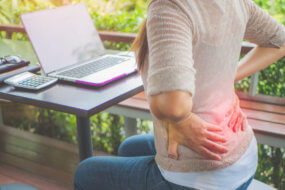
When contemplating back pain, we must understand its variations. Back pain, for example, may begin with a slip disc, also known as a “herniated nucleus pulposa” in medical terms. (HNP) formalised paraphrase Slip discs are described by doctors as ruptures of the “intervertebral disc.” The intervertebral disc is located between the vertebrae of the backbone (Spinal Column).
The disruption has many variations, including the “Lumbrosacral” (L4 and L5) and cervical C5-7. The cervical spine is located at the hip and connects to other parts of the back and neck. When physicians consider slip discs, they also consider aetiology, which involves neck and back strains, trauma, congenital/inborn bone malformation, heavy lifting, degenerated discs, and/or ligament weakness.
Etiology doctors carefully examine Pathophysiology, which involves protrusions of the “nucleus pulposus.” The centre binds to the column or spinal canal, potentially compressing the spinal cord, nerve centre, or roots, resulting in back pain. Back pain, numbness, and motor function failure are common when the spinal cord is compressed, restraining the roots and cord.
In medical terms, the tests are focused on Lumbrosacral, which can involve acute or chronic pain in the lower back. The pain can radiate to the buttocks and then to the legs. The individual can experience weakness and numbness. Furthermore, such pain can cause tingling in the legs and feet. The final assessment can involve ambulation as a result of pain.
The cervical spine is taken into account. Experts look for signs such as neck rigidity, deadness, fatigue, and “tingling” in the hands. If the pain in the neck extends to the arms and then to the hands, experts will suggest slip discs. Other symptoms, such as weakness that affects the farthest points or the higher limits of the body, can occur. The lumbar curves are located in the lower back region and are located in the loins or the smaller part of the back, which doctors consider as well, particularly if the patient has difficulty straightening this area with the curvature of the spine (scoliosis) and away from the affected area.
When a doctor considers back pain, he or she will check the diagnostics after a battery of tests. Tendon reflex, x-rays, EMG, myelograms, CSF, and/or Laséque symptoms can all be used to make a diagnosis. CSF assists doctors in analysing protein increases, while EMG assists experts in determining the role of the spinal nerves. X-rays are used to assist specialists in viewing the limited disc space. Tendon reflexes are measured, which doctors use to look deep into the stressed area, or the absence of upper boundary reflexes, or the Achilles’ reactions or reflex in medical jargon. Myelograms help the specialist in determining if the spinal cord is compressed. If the Laséque signs show positive results behind aetiology observations, Pathophysiology, assessments, and so on, the tests begin.
Slip discs are managed by physicians in the following ways:
In medical systems, doctors recommend management to isolate or alleviate back pain. Dietary restrictions can be included in management plans, with calories determined by the patient’s metabolic needs. The doctor can advise you to increase your fibre intake as well as force fluids.
Hot pads, moisture, and other forms of care or management, as well as hot compressions, can be used in addition to hot compressions. Pressure relievers, such as those used to treat NAID, are often prescribed by doctors. Motrin, Naproxen, Dolobid or Diflunisal, Indocin, ibuprofen, and other pain relievers are available. Muscle relaxants, such as Flexeril and Valiums, can be prescribed in addition. The most commonly used relaxers are diazepam and cyclobenzaprine hydrochloride, with diazepam being valiums and the other Flexeril.
Orthopedic mechanisms, such as cervical collars and back braces, are also used to treat back pain.





